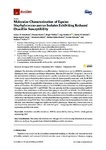Molecular Characterization of Equine Staphylococcus aureus Isolates Exhibiting Reduced Oxacillin Susceptibility
Scholtzek, Anissa D.
Hanke, Dennis
Walther, Birgit
Eichhorn, Inga
Stöckle, Sabita D.
Klein, Katja-Sophia
Gehlen, Heidrun
Lübke-Becker, Antina
Schwarz, Stefan
Feßler, Andrea T.
The detection of borderline oxacillin-resistant Staphylococcus aureus (BORSA) represents a challenge to both, veterinary and human laboratories. Between 2015 and 2017, 19 equine S. aureus with elevated minimal inhibitory concentrations for oxacillin were detected in routine diagnostics. The aim of this study was to characterize these isolates to identify factors possibly associated with the BORSA phenotype. All S. aureus were subjected to antimicrobial susceptibility testing and whole genome sequencing (WGS). A quantifiable β-lactamase activity assay was performed for a representative subset of 13 isolates. The WGS data analysis of the 19 BORSA isolates identified two different genomic lineages, sequence type (ST) 1 and ST1660. The core genome multilocus sequence typing (cgMLST) revealed a close relatedness of all isolates belonging to either ST1 or ST1660. The WGS analysis identified the resistance genes aadD, dfrG, tet(L), and/or blaZ and aacA-aphD. Phenotypic resistance to penicillins, aminoglycosides, tetracyclines, fluoroquinolones and sulfamethoxazole/trimethoprim was observed in the respective isolates. For the penicillin-binding proteins 1–4, amino acid substitutions were predicted using WGS data. Since neither transglycosylase nor transpeptidase domains were affected, these alterations might not explain the BORSA phenotype. Moreover, β-lactamase activity was found to be associated with an inducible blaZ gene. Lineage-specific differences regarding the expression profiles were noted.

